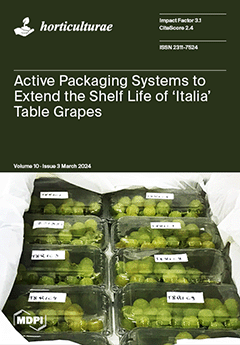Sweet clover (
Melilotus albus) is a high-quality leguminous forage grass with salinity tolerance, drought tolerance, and cold hardiness. We selected four varieties of sweet clover with different sensitivities (061898, 061930, No. 55 white flower, and Ningxia white flower) and analyzed the
[...] Read more.
Sweet clover (
Melilotus albus) is a high-quality leguminous forage grass with salinity tolerance, drought tolerance, and cold hardiness. We selected four varieties of sweet clover with different sensitivities (061898, 061930, No. 55 white flower, and Ningxia white flower) and analyzed the effects of different concentrations of three sodium salts (Na
2CO
3, NaHCO
3, and NaCl) on their physiology and biochemistry responses. Growth and development indexes (such as germination rate, root length, shoot length), chlorophyll content, osmotic regulators (proline, soluble sugar), malondialdehyde (MDA), superoxide dismutase (SOD), peroxidase (POD), and catalase (CAT) were determined under saline–alkali stress. Seed germination and seedling growth of all four clover species were significantly inhibited under saline–alkali stress. During germination, seed germination rate, root length, and shoot length decreased with increasing saline and alkaline concentration. Under saline–alkali stress, chlorophyll content tended to increase and then decrease, cell damage and death increased, and malondialdehyde, soluble sugar, and proline content tended to increase and then decrease. Moreover, the activities of SOD, POD, and CAT all increased and then decreased. Under Na
2CO
3 stress, the decrease in chlorophyll content of the resistant variety 061898 was less than in the sensitive Ningxia white flower variety. As the concentrations of Na
2CO
3, NaHCO
3, and NaCl increased, the maximum photochemical efficiency of PSII was significantly affected. The resistant 061898 is capable of maintaining higher photosynthetic efficiency. Furthermore, under treatments with the three kinds of saline–alkali solutions, cell damage and death for Ningxia white flower were greater than in 061898. For 061898, the increases in soluble sugar and proline content were greater and the increase in malondialdehyde content was less, while the antioxidant enzyme activities were higher than those in Ningxia white flower. All four sweet clover varieties had higher stress resistance with neutral than with alkaline salts. When stressed by medium to high saline–alkali concentrations, sweet clover seedlings had increased osmotic substance content, enhanced antioxidant enzyme activity, and regulated physiological metabolism. Additionally, sweet clovers regulated the expression of
WRKY33,
GH3,
CYCD3,
OXI1,
MKK2,
MYC2,
JAZ,
COI1,
PYL,
PP2C,
TGA, and
MPK3 to adapt to the saline–alkali environment and improve saline–alkali tolerance. Our analysis of the sweet clover salinity tolerance mechanism contributes to its further use and is of significant importance for addressing land salinization and promoting sustainable agricultural and pastoral practices in China.
Full article





